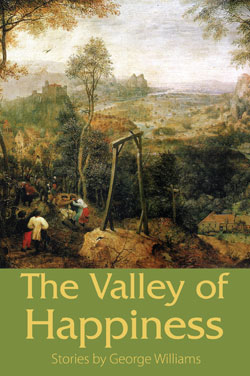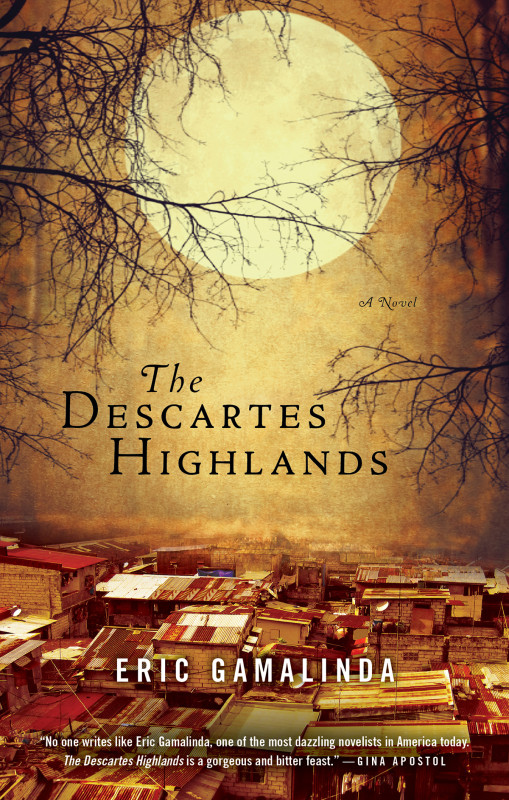“Neurologically Speaking,” by Mercedes Lawry (first appeared in Issue 6 of elsewhere)
Poems from Superstition Review, a brief interview in Agave Magazine.)
This (very) short prose work begins with a quotation from Louis Pasteur. Ms. Lawry uses Pasteur’s words as a jumping-off point for what appears to me to be a look at how Ms. Lawry believes her mind works and the kinds of thinking that result in inspiration. (The author may, of course, have a different idea about her piece and that’s okay, too.)
One of the things I like most about this piece is the implied suggestion that Ms. Lawry is making to the rest of us. If you’re like me, you like to play around and experiment with writing. Why not borrow Ms. Lawry’s idea and find some wise words from the past and create something new out of what you think they mean?
I’m not exactly the most “quote”-infatuated person. They just don’t inspire me on their own in the way they do for many people. That’s not to say that I don’t derive some kind of enlightenment and pleasure from reading inspirational extracts; I guess I just prefer understanding “quotes” in context. (I’m a storyteller and a plot person; I suppose this makes sense.) My proclivity certainly doesn’t prevent me from participating in the experiment I’m proposing. For example, one of my favorite sentences (and final sentences) is from Animal Farm:
The creatures outside looked from pig to man, and from man to pig, and from pig to man again; but already it was impossible to say which was which.
There are so many jumping-off points! I could write prose poem similar to Ms. Lawry’s about the thoughts that Orwell’s work evokes in me:
- The inability that many people have to recognize the real “bad guy” in situations.
- My feelings of being an outsider as I look upon others who have undeserved success. (I’m thinking Kardashians.)
- I really like pork chops and I wish I knew more about food science. The Maillard Reaction is the magic that creates the complicated flavor in browned meat. I also grew up without using salt, which somehow adds some magic to my current (and intermittent) culinary adventures.
See? Look how thinking about a “quote” can get some thoughts rolling around your head! What happens if you do the same?
I also like the way Ms. Lawry contradicts and gets in the way of Pasteur’s thought. By beginning with “I have no prepared mind,” Ms. Lawry is doing something that reminds me of my improv comedy roots. In a way, she’s “blocking” Pasteur. A “block” is when a performer says NO to something a scenemate has said. Blocks are (usually) killers because they stop the scene.
Bob: Hey, look at this beautiful dog I found!
Sally: That’s not a dog. It’s an elephant.
See how Sally messed up the scene? Now the audience thinks Bob has been walking around with an elephant in his arms. Everything has screeched to a halt. Sad. When you’re working with other people, particularly in an endeavor such as improv, you just can’t block in this manner. See how beautiful and creative people can be when they say “yes, and” instead of “no?”
But guess what…writing is a solitary pursuit and you can do whatever you like! Further, your characters will say or do anything you want, so blocks can be useful in creating a number of dramatic effects. Why not employ blocks to create drama and to establish character?
Have you seen Breaking Bad? If not, what are you waiting for? Go watch it NOW.
Okay, you’re back. Here are some examples from Breaking Bad that illustrate how blocking results in high-wire tension.
Remember when Skyler told Walt to go to the police and confess that he’s a drug king? Walt says no. Skyler tells Walt he’s in danger. Walt uncorks a crackerjack monologue:
That’s right…Walt is the one who knocks.
The whole point of Breaking Bad is to chronicle the moral evolution and tragic downfall of Walter White. Gus Fring asks Walt to serve as his meth chef in a Superlab. Walt will have all of the cool scientific equipment he needs to make the purest meth possible. (You have to admire Walt’s dedication to chemistry…) How does Walt respond to the request? He says no.
Arguments and discussions need some conflict and that sometimes requires characters to contradict each other. In this case, Gus is forced to persuade Walt to join him:
Think about a scene you’re building or a poem you’re working on. What if one character says “no?” What if there’s some unexpected internal or external opposition to the idea you’re expressing? Experiment with blocking to see if you can add unexpected power to your work.
Exercises, Short Story
Breaking Bad, elsewhere, Mercedes Lawry
Friends, I had the honor of doing this interview with George Williams, a short story writer and novelist who teaches at Savannah College of Art and Design.
Mr. Williams is a very interesting man who had the great fortune to work with Donald Barthelme, whose writing marginally resembles the stories in The Valley of Happiness. If you don’t know Mr. Barthelme’s work, why not pick up one of the man’s books? Failing that, it looks as though a kind Internet citizen has secured permission to collect some works online. (Cool…look at one of Mr. Barthelme’s syllabi!)
(A slight tangent: one of the things in life for which I’m most grateful is that I can say that I worked with some all-time great writers and teachers: Ira Sukrungruang, Robert O’Connor, Lee K. Abbott, Lee Martin, Erin McGraw, Kathy Fagan, Michelle Herman… Writers and scholars are all part of a line of knowledge seekers that goes all the way back to Socrates and beyond. Mr. Williams is in Mr. Barthelme’s line. I know folks who are in Raymond Carver’s line. We should all take a moment to reflect upon how thankful we are for the teachers we’ve had along the way.)
One of the stories in Valley is titled “Televangelist at the Texas Motel.” The story is a single page; three paragraphs of relentless sentences and exclamation points. When I read the story, I made the note that the piece is “a kind of prayer.” During the course of our conversation, Mr. Williams pointed out that “Televangelist” began life as an exercise assigned by Mr. Barthelme, who told his students to write a rant.
Remember, friends, no word we write is ever a waste. Even when our lines are flabby and our characters flat, we’re building our skills and increasing the likelihood that the next piece will be better. In many cases, including this one, exercises can even be published. This story appeared in Gulf Coast in 1989.
Mr. Williams has published two collections, both with Raw Dog Screaming Press. Both volumes also feature jacket art created by great artists who also happen to work for free, seeing as how they’ve been dead for hundreds of years. The tone of The Valley of Happiness and its stories is set by “The Magpie on the Gallows,” a painting by Pieter Bruegel the Elder.
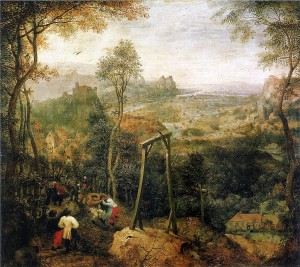
Mr. Williams admires the feeling of the painting. At first, you think that one of the men is being led to the gallows for a hanging. Then you realize that there is simply a party happening…in the same place where those folks witness executions.
For this exercise, I’m pretend-assigning you in Barthelme style to compose a rant based upon a classic (public domain) painting. What are some of the qualities of a rant?
- Extreme emotion. Rants are what happen when our reasonable rhetoric has been ignored.
- Brazen language. Subtlety doesn’t quite work for a rant.
- A subject worthy of the above. Did the drive-through worker forget to give you a third napkin? You’ll live. Confront a subject of real importance to the individual or the larger world.
Here are some examples. Feel free to download the images so you can see bigger versions.
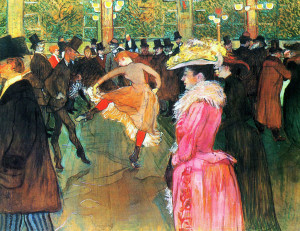
Henri de Toulouse-Lautrec’s “At the Moulin Rouge, The Dance”
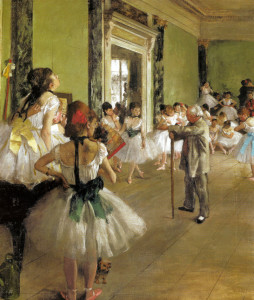
Edgar Degas’ “The Dance Class”
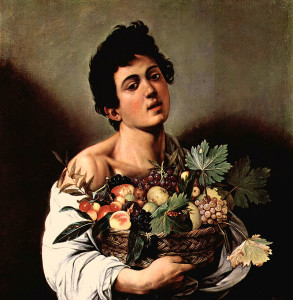
Caravaggio’s “Boy With a Basket of Fruit”
There’s plenty to rant about in these paintings. Are you pleased or angry that the all-male space seems to have been turned into a co-ed gathering? Can you believe what the ballerina with the green bow said about the one with the yellow bow? They’re supposed to be friends! And can you believe the lengths to which dieticians will go to try and make you add more fruits to your diet?!?!?
Those paintings don’t do anything for you? That’s fine. There are plenty more paintings where those came from. You can find 44,000 paintings here.
Want an example of an audio rant? Here’s playwright/comedian Lewis Black laying down some truth:
Good luck writing your own rants. You never know; you might produce a publishable piece of work! And keep in mind that you could always paste the result of your labor into a comment on this page. Who knows? Maybe I’ll publish your rant on its own page and write about what we can learn from you!
Exercises
Donald Barthelme, George Williams, Raw Dog Screaming
Friends, I had the honor of doing this interview with Eric Gamalinda, whose novel The Descartes Highlands is available from Akashic Books.
Mr. Gamalinda is a fantastic writer of prose, but he is also a film scholar who enjoys working cinematic images into his work. Film and prose are, of course, wildly different media. They are, however, quite similar in that they both allow you to tell a story and to describe characters and their surroundings.
Approximately halfway through The Descartes Highlands, Mr. Gamalinda made use of an image from Andrei Tarkovsky’s Nostalghia. The following passage of the book reminded me of a still from another important film:
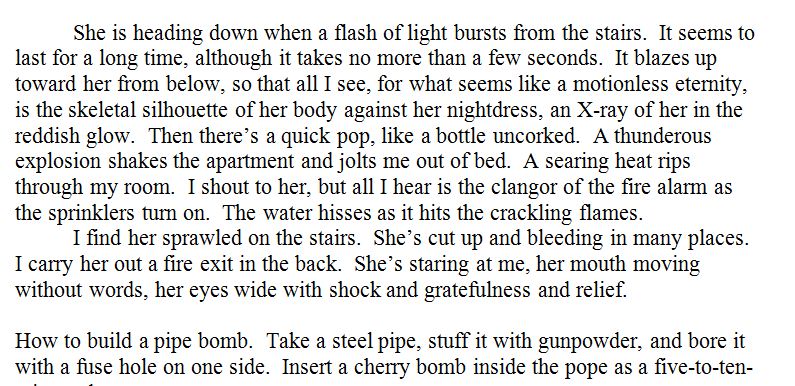 Doesn’t the description of the mother’s eyes remind you of Janet Leigh’s last scene in Psycho?
Doesn’t the description of the mother’s eyes remind you of Janet Leigh’s last scene in Psycho?

Filmmakers borrow from writers and vice versa all the time. Why not grab a pen and notebook?
1) What imagery might you steal from one of these scenes? How can you use language to match the power of the audio/visual representation of the same moment in time?
2) What would it look like if you adapted one of these scenes? How can letters, words, punctuation and white space be arranged in such a way that your paragraphs communicate the same emotions and plot as the film does?
The Omaha Beach invasion scene from Spielberg’s Saving Private Ryan:
The cringeworthy, needleriffic scene from Tarantino’s Pulp Fiction:
The mind-blowing one-take Steadicam scene from Scorsese’s Goodfellas:
Oh my, I loved this movie. The fight scene from Blue is the Warmest Color/La Vie d’Adele:
The touching scene between two powerful women from Crouching Tiger, Hidden Dragon:
The heartbreaking final scene of Lean’s Brief Encounter:
Which powerful scenes have I failed to include? Want to share the poetry and/or prose that results from this exercise? The comments are right there waiting for you.
Exercises, Video
Akashic Books, Eric Gamalinda, GWS Exercise, The Descartes Highlands
If you heard my craft interview with Jac Jemc, author of A Different Bed Every Time, you heard her give away one of her secrets to writing beautiful sentences:
A lot of what I do before I start working is gathering language from other sources…I steal a lot. So what I’ll do is I’ll just sort of scan pages of books I’m reading and pull out words that are most vivid and exciting to me and try to pair them in ways…It’s just an exercise in trying to match things up in a way I wouldn’t normally do.
I also will look at texts in other languages that I know poorly…I’ll try to read something complex in one of those languages and translate it, but for the most part, it’s wrong. Maybe I’m getting 25 to 50 percent of it right, but the way that I force myself to bridge those little gaps with cognates and things, it creates some fun language.
So let’s try it!
Can you read Latin? I wish I could. Here’s the original Latin text of the Magna Carta. Isn’t it amazing how you can pick up a little bit of what the document says? I know “rex” means “king.” I know “Dominus” because of “dominate.” “Hibernie” must be an old form of “Hibernia.”
If I were writing a fantasy or science fiction story, it would be a great idea to do an awful translation of the Magna Carta and use the result as the founding document of a government you create for the piece. It would also be fun to pluck the words and sentences you like best and use them as dialogue for a character who speaks an alien or dead language. Latin speakers would get the joke, and the rest of us would simply get the drift.
John Williams did something similar when he composed “Duel of the Fates” for Star Wars. He needed his chorus to sing some lyrics that sounded big and magical and timeless and meaningful…so he set the piece to a loose Sanskrit translation of “Cad Goddeu,” an ancient Welsh poem.
Think about it…would the piece sound as powerful if it had English lyrics?
Get him…
Beat him up…
He’s a…
Real bad guy…
He has…red blades…on his…saber.
Wants to…kill the…good guy…Jedi.
Noooooooooooooooo…
No, that wouldn’t work. Instead, we should follow Ms. Jemc’s lead and play with languages in which we’re not quite fluent.
Want to try it yourself? Here are some examples of some documents that should be fun to translate:
Here are Martin Luther’s original Ninety-Five Theses. And here‘s an English translation.
Here‘s the German original of Goethe’s Faust.
Here‘s the French original of Molière’s Tartuffe.
Here are Nostradamus’s original quatrains.
Another facet of Ms. Jemc’s work that I admire is that she likes to work from prompts at times. You may have heard my reaction; I love to “write to order” sometimes. Ms. Jemc was asked to write a piece for a Melville House book intended to compile short stories for each of the Presidents of the United States. (Not the band, the actual people.) Ms. Jemc was lucky indeed to draw the assignment to write about Thomas Jefferson; a particularly interesting POTUS.
Here’s the result: “Head and Heart.”
It is, of course, impossible to chronicle every current call for submissions that includes a specific prompt or theme. There are, however, plenty of web sites that do an awfully good job trying to keep up.
Duotrope is probably the gold standard for market listings. For a small sampling of what they offer, check out their Twitter feed.
The Calls for Submissions Facebook group has 23,000 members! You’ll find lots of solicitations there; many of which are from editors looking for prompt-related material.
Do you know about NewPages? You certainly should! They’re one of the few outlets where you’ll find reviews of literary magazines. NewPages also maintains a classifieds section that features lots of great calls for submissions.
We might not be able to write exactly like Jac Jemc…but that’s okay! We’re all different writers. We can, however, exercise our skills by following her lead in a couple ways:
- Do bad translations of foreign prose to open our minds to new words and new ways of putting words together. We’ve been speaking and writing in our primary language so often and for so long that the rhythms of another tongue can shake us from our linguistic slumber.
- Find an interesting prompt and follow the rules they provide to produce a new work. Writers love to have freedom, but cool things can happen when we restrict our creativity a little bit.
Exercises, Short Story
Dzanc Books, GWS Exercise, Jac Jemc


